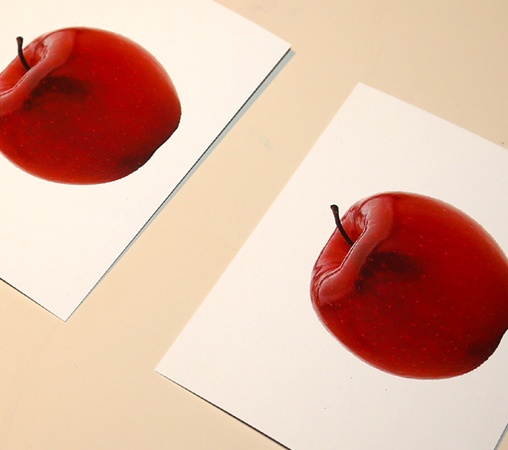Identical Matching Lesson Plan
Lesson Overview:
This lesson plan teaches fine motor and receptive language skills in order to have students match identical pictures of familiar objects.Objective:
Students will learn to match identical pictures of familiar objects in this lesson.Skills Practiced:
- Fine motor
- Receptive language
- Image matching
Materials Needed:
-
Stages Learning Materials Language Builder Picture Noun Cards.
- The following 15 words make up the Basic Stage Set. Each word has multiple picture representations, but you will only need the first two cards for each word in this lesson. These cards are identical:
#1 & 2 (Apple) #8 & 9 (Cookies) #15 & 16 (Cat) #22 & 23 (Bird) #29 & 30 (Airplane) #36 & 37 (Car) #43 & 44 (Shoes) #50 & 51 (Shirt) #57 & 58 (Chair) #64 & 65 (Bed) #71 & 72 (Bicycle) #78 & 79 (Ball) #85 & 86 (Spoon) #92 & 93 (Cup) #99 & 100 (Flower)
People:
- This lesson is designed for 1:1 instruction with a teacher or therapist
Set Up:
Procedures:
    |
Place one of the cards on the table facing your student. Hand your student the corresponding card and ask him or her to match the two. Your student can progress through 3 steps with this activity. Each step will be discussed here, progressing from basic to more advanced: Matching the card while only the target card is on the table:
Matching the cards with the target card when there is also a blank distractor card on the table:
|
Matching the cards with both the target card and one or more other pictures on the table. (This is the task the previous two activities have been building up to):
-
Place card #1 (apple) on the table, along with one other picture card (for example, #192 bus).
-
Hand the student card #2 (the same picture) and ask him or her to match it to its identical card.
- Now your student has to look at each picture card and determine which one matches the apple ca
 rd you have given him or her.
rd you have given him or her. - Again, you should try this activity several times while randomly changing the position of the target card and the other picture card.
- You should also switch out the other picture card a few times (for example, use the school bus for a few rounds, then switch to the picture of the chicken.)
- Now your student has to look at each picture card and determine which one matches the apple ca
-
As your student becomes proficient with this activity using one picture card as a distractor, try adding another distractor card, either a picture or blank card, to make this activity more advanced.
- Remember to randomly adjust the position of the target and distractor cards on the table after each round. Your student should be able to accurately match the identical card regardless of its position on the table.
- Remember to randomly adjust the position of the target and distractor cards on the table after each round. Your student should be able to accurately match the identical card regardless of its position on the table.
- When your student masters this activity with the apple cards, try it with each of the remaining 14 Basic Stage identical cards.

Jenna Wharff, Ed.M.
Jenna Wharff is a special education teacher at HOPEhouse at Cotting School, a transitional boarding school for students age 17-22 with special needs, in Lexington, MA. She specializes in helping her students prepare for life after high school by teaching independent living, vocational, and social skills as well as practical academics and providing opportunities for her students to apply what they have learned in the classroom to their everyday lives. She aims to help students and their families make the transition from special education to adult services as smooth as possible, while providing her students with the skills and knowledge necessary to lead productive and meaningful lives after leaving HOPEhouse. Jenna received her Master's degree in Mind, Brain, and Education from Harvard Graduate School of Education in 2007.






